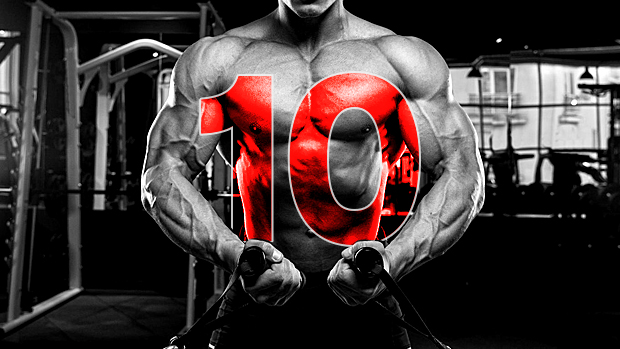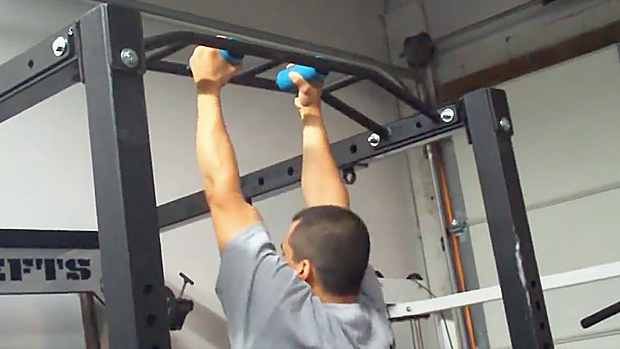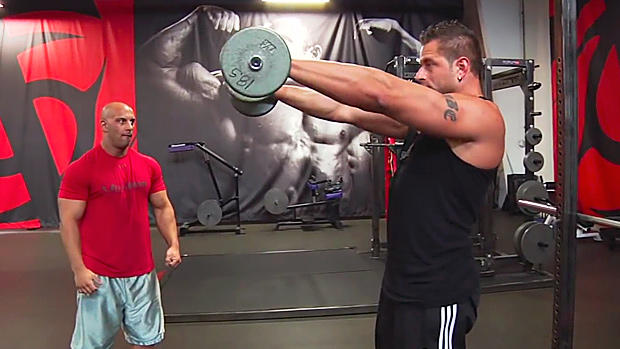You know the typical mass building advice: emphasize big compound lifts and progressive overload. However, using exercises you're not structurally suited for can quickly turn you into a non-gainer. This is especially true for lanky, long-limbed lifters.
If you want build muscle, you need to make every exercise count. Use these effective and structurally-friendly variations of the classic exercises.
For building mass, squats are king. However, when long-limbed hardgainers try to back squat, if often looks like an ugly good morning. Switching to a safety squat bar (holding the squat rack) is a game changer.
Benefits
- The padded yoke takes stress off your shoulders.
- The bar design moves the weight forward like a front squat. This means less stress on your spine and more on your quads.
- Holding the rack helps you keep a more upright torso. This makes your squat look more like the pretty squats of someone with a good squat structure. It also adds some extra stability to the lift, which lets you lift more weight for more reps.
Tips
- For big legs, don't sit back like a powerlifter. Instead spread your knees and sit down.
- Drive your traps into the bar pad as you come out of the hole.
- If you start leaning forward to recruit more low back and hips, use your hands to push the weight back over your feet and make your quads do the work.
- Don't cheat with your arms. You're trying to build your legs, not your ego.
Good alternatives: Machine squat, leg press, Zercher squat, hip belt squat.
While regular deadlifts are fantastic for building overall strength, Romanian deadlifts rule for packing mass onto your posterior chain. Use a hook grip or straps for this.
Benefits
- EMG research shows it's one of the best hamstring exercises (1).
- It's hard to do, but easy to add 5 pounds a week on for a long time!
- Great for building your upper back and traps.
- Keeps continuous tension on the muscles.
- It's easier on your lower back than the traditional stiff-legged or straight-leg deadlift because you maintain a neutral low-back position.
- By starting from a rack at the top, your body structure doesn't matter.
Tips
- Use straps or a hook grip so you can focus on your hamstrings, use more weight, and get more reps.
- Take the weight from a rack (or deadlift the first rep if no rack).
- Unlock your knees, then push your hips back until you get a good hamstrings stretch.
- Stop the downward movement just before you have to bend at your spine.
- Resist the urge to let your knees go forward at the bottom. This takes tension off your hamstrings and turns the lift into a quarter-squat holding a barbell.
- Don't overdo the hip lockout at the top unless you're trying to make this a glute exercise.
Good alternatives: Trap bar deadlift (touch and go), back extension (45 degree), glute-ham raise.
Notes: Using a trap bar for deadlifts will hit your hamstrings less, but they're still a great total-body mass builder. Back extensions and glute ham raises are also excellent hamstring builders, but they won't have a huge impact on total-body muscle growth.
With long arms, most hardgainers find that bench presses beat up their shoulders long before they build up their pecs. Chest dips are an amazing mass builder and they can be even better when you do them on rings.
Benefits
- The rings allow you to have the perfect hand position for your individual structure, which reduces shoulder stress.
- Your chest has to work even harder to keep the rings from moving out.
- It's not as unstable as you might think. Because your arms are on the straps, they'll provide some stability.
Tips
- Wear a long sleeve shirt so the ring straps don't shred the skin on your upper arms.
- Test your natural range of motion by standing sideways to a mirror. Lean forward like you're doing a chest dip. Now bring your elbows back as if doing a dip. Stop when you run out of range. That's your natural range.
- Keep the ring height lower so you can bail yourself out with your feet if something goes wrong.
- At first you'll be really shaky with these. Don't worry, your body will quickly figure it out. Just go extra slow while you're learning the movement.
- Lean forward as you come down to emphasize your pecs.
- Squeeze your pecs as you press down on the rings to raise your body.
- Dips aren't for everyone. If they bother your shoulders, explore other alternatives.
Good alternatives: Chest dip on V-bar setup, dumbbell bench press (flat, low incline or slight decline), weighted push-up.
Bent over rows are a classic upper-back mass builder and they work even better with a trap bar.
Benefits
- The trap bar moves the weight from in front of you back to your midline, which takes stress off your lower back.
- Because your knees don't get in the way of the bar, you can use more legs and less low back to support the weight.
- The neutral hand grip of the trap bar brings the elbows closer to your sides. This makes it easier to get a good scapular retraction. This elbow position also increases the work of your lats (a powerful shoulder extensor) which builds back width and lets you use more weight.
Tips
- Play with your torso angle to find what feels the best.
- Find the optimal level of knee bend to feel strong and take stress off your lower back.
- Keep pressure over your mid foot. Roll your shoulders back as you row.
- Keep your form tight while learning the movement. As you get more advanced, you can experiment with a little body English. Just don't get carried. No one cares how much you row.
- Don't cheat by bringing your torso more upright as you get tired.
- Keep tabs on your low back. If you still find this row variation too much for your back (especially with your leg training), consider the alternatives.
Good alternatives: Weighted inverted rows, chest-supported row.
Make sure to use a slight elbow tuck on this one.
Benefits
- Researchers compared seated versus standing, and barbell versus dumbbell shoulder pressing. They found that the standing dumbbell shoulder press hits your delts the hardest (2).
- Standing (done correctly) puts less compression on your spine than sitting (3).
- A slight elbow tuck takes your shoulder out of the vulnerable "high-five" position. It moves your shoulders into the scapular plane which is a much more joint-friendly position for safe pressing.
- When sitting, most people will kick the dumbbells up to their shoulders with their knees. This work with short arms, but leaves long-limbed lifters with their arms folded up and struggling to get the weights off their shoulders. When you stand, you can use your hip power to swing the weights up into a solid starting position.
Tips
- Use an explosive hip hinge to swing the dumbbells up.
- Keep your abs tight and your glutes locked so you have a firm foundation to press from.
- Use a slight elbow tuck.
- Maintain a vertical forearm while you press.
Good alternatives: Seated dumbbell shoulder press, high-incline dumbbell press (great for those who have a shoulder structure not suited to direct overhead pressing).
Chin-ups are a classic lat and bicep builder. Rings will amplify your benefits.
Benefits
- The supinated grip draws your elbows in. This position is more joint friendly for your shoulders and hammers your lats as shoulder extensors.
- You get some serious mechanical tension on your biceps.
- Rings keeps you honest. If you start jerking and kipping, you'll be swinging around the gym like Tarzan.
- Free moving handles reduce joint stress. This allows you to do more weight and more volume.
Tips
- Take an underhand, supinated grip.
- Keep your chest up, shoulders down, and lean back a bit. Focus on driving your elbows down as you lift.
- Focus on squeezing your biceps as you come to the top. Extend your elbows as you come down, but don't go limp.
Good alternatives: Use the rotating handles that come with some high-end racks, or use the D-handles found at most gyms. All you need is a small chain and carabineer you can pick up from a hardware store.

If you have to use a fixed bar, alternate every 1-2 months between supinated and neutral (palms facing each other) grips to reduce the risk of joint problems.
While close-grip presses are great, MRI research shows that these exercises emphasize your lateral and medial triceps heads, not your long head (3). However, things change when you follow Mark Rippetoe's advice to combine a pullover with a traditional skull crusher.
While it looks like you're cheating with your lats, the long head of your triceps is a two-jointed muscle. It extends your elbow and extends your shoulder. Yes, your lats help, but they simply work with your triceps and allow you to use more weight for more reps.
Benefits
- You hammer the long head of your triceps – the biggest head which makes the biggest difference in your overall triceps size.
- Less elbow stress than traditional triceps extensions.
Tips
- Bring the weight back behind your head like you're doing a pullover. Get a nice triceps stretch, but don't overdo it.
- As you come up, simultaneously move your elbows up as you extend them.
- Don't bring your upper arm all the way to vertical; this will take tension off your triceps at the top.
- Start slow to get the hang of this, then add some controlled speed. Remember, your triceps are fast-twitch dominant muscles and they love speed.
- As you get stronger, hook your feet under a sturdy object or have a training partner hold your knees down.
Good alternative: Dumbbell pullover extension.
When you curl, the weight moves out in front of your feet and out of your base of support. Long, lanky arms amplify this problem. When the weights get heavy, your focus shifts away from your biceps to stabilizing your body. However, this old school training accessory fixes the problem.
Benefits
- By resting your triceps on the arm blaster, you can focus on flexing your biceps.
- This gives you similar isolation to preacher curls without the added elbow stress at the bottom and loss of tension at the top.
Tip
- Resist the urge to let you triceps move off the arm blaster as you curl the weight up.
Good alternatives: Curl with your back against a wall, seated dumbbell curl.
Farmer's walks are a game-changer for total-body strength and size. However, there's a good chance you don't do them because your gym doesn't have farmer's walk bars or a nice long strip of turf to do them. Enter the trap bar figure-8 farmer's walk.
Benefits
- Great for building your upper back and traps.
- Easy to load heavy. Unless your gym has farmer's walk implements, you'll quickly out-grow this exercise using dumbbells or kettlebells.
- They make turns easier. Even if you have access to farmer's walk implements, you'll find them very difficult to turn when the weight gets heavy. This can place a lot of extra rotational torque on your lower back. This isn't a big deal if you have a nice long runway. With a trap bar, you can easily do a figure-8 pattern in a relatively small area. This gives you a practical way to lift heavy weight AND extend your time under tension.
Tips
- Dig your hands into the handles in the set-up. Don't just hold the weight – crush it!
Maintain perfect deadlift technique as you lift the weight. - Resist the urge to rush. A slow, controlled pace makes the turns easier, reduces your risk of tripping, and extends your time under tension.
- Keep your chest up even as you get tired.
- At the end of your set, stop your body and the weight, then lower under control (again, think proper deadlift form).
Good alternative: Use heavy dumbbells or kettlebells – a temporary fix until you get your gym to buy a trap bar.
Donkey calf raises are an old-school classic. The angled barbell version gives you all the same benefits, plus the added benefit of skipping awkward conversation where you ask a stranger at the gym to mount you like a horse.
Benefits
- There's no spinal compression.
- You get a nice stretch in the calves.
- It's easy to go heavy.
- Limited EMG research suggestions donkey calf raises are one of the best exercises for hammering your calves (5).
Tips
- If you're strong, invest in a belt made for hip-belt squats instead of using a dip belt.
- Come down to a nice stretch at the bottom and then drive up hard on the balls of your feet. Squeeze your calves at the top.
- Don't bend your knees and cheat with your quads.
Good alternative: Calf press on the leg press.
- McAllister MJ et al. Muscle activation during various hamstring exercises. J Strength Cond Res. 2014 Jun;28(6):1573-80. PubMed.
- Saeterbakken AH et al. Effects of body position and loading modality on muscle activity and strength in shoulder presses. J Strength Cond Res. 2013 Jul;27(7):1824-31. PubMed.
- James MM. Biomechanics of the spine. Arch Surg. 1973;107(3):418-423.
- Tesch PA. Target Bodybuilding. Windsor, ON: Human Kinetics. 1999.
- Bompa TO et al. Serious strength training. Windsor, ON: Human Kinetics. 1998.





